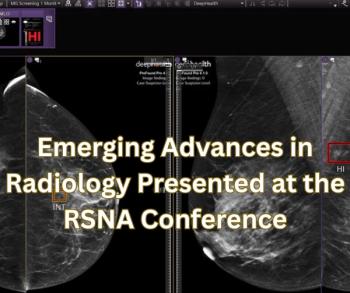
Workstation session explores issues of policy and trust
Three-D is all the buzz, as PACS companies struggle to include it in their products, if they haven’t already. But where this form of advanced visualization fits into the diagnostic process is still up in the air. Ironically, so are some of the everyday tools on which advanced visualization depends. Trust issues about the automation that makes sophisticated postprocessing viable are beginning to surface, just as progress in CAD offers new clinical capabilities.
Three-D is all the buzz, as PACS companies struggle to include it in their products, if they haven’t already. But where this form of advanced visualization fits into the diagnostic process is still up in the air. Ironically, so are some of the everyday tools on which advanced visualization depends. Trust issues about the automation that makes sophisticated postprocessing viable are beginning to surface, just as progress in CAD offers new clinical capabilities.
On Wednesday, May 19, Dr. Jeffrey Mendel, an assistant professor of radiology at Tufts University, will argue in favor of routinely reading studies in 3D. Doing so improves confidence and speeds interpretations of neuro images. It also helps localize masses just about anywhere, according to Mendel. Making 3D part of the routine will be discussed in terms of a broader PACS strategy that involves not only interpretation but access, distribution, and archiving of the data.
Dr. Jacob Sosna, section chief for CT at Hadassah-Hebrew University Medical Center in Jerusalem, will examine the absence of tools for evaluating the precision of segmentation algorithms, which are increasingly being adopted. The significance of not being able to compare the performance of these algorithms will grow as the community becomes ever more dependent on them. Sosna will demonstrate, however, that the algorithms can be compared, illustrating this with data generated using algorithms that grade automated carotid bifurcation lumen segmentation and stenosis.
Laura J. Pierce, 3D Lab Manager at Stanford Radiology, will speak on the role of quality control programs in 3D imaging, noting the operator dependence of 3D and how missteps can lead to anatomical misrepresentations, as well as delayed or inappropriately altered patient treatment. Among the sources of error are data entry, incorrect segmentation, and annotation. Pierce will explain how the types of errors must first be recognized, including types of errors in postprocessing, PACS workflow, and measurement, and how, once the causes of errors are documented, these errors might be prevented.
The promise of CAD for pulmonary embolism identification has been one of the great unrealized potentials of CT. Dr. Charles White, director of thoracic imaging in the University of Maryland radiology department, will look at how thin-slice data and advances in CAD technology have set the stage for advances in PE CAD, presenting data demonstrating its promise as a stand-alone tool and as a second reader.
Newsletter
Stay at the forefront of radiology with the Diagnostic Imaging newsletter, delivering the latest news, clinical insights, and imaging advancements for today’s radiologists.




























